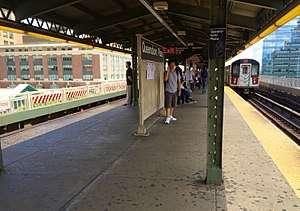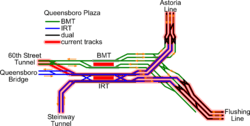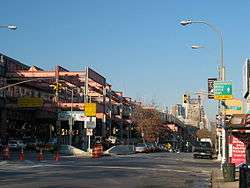Queensboro Plaza (New York City Subway)
Queensboro Plaza | |||||||||||
|---|---|---|---|---|---|---|---|---|---|---|---|
|
| |||||||||||
 Upper-level platform | |||||||||||
| Station statistics | |||||||||||
| Address |
27th Street & Queens Plaza Long Island City, NY 11101 | ||||||||||
| Borough | Queens | ||||||||||
| Locale | Long Island City | ||||||||||
| Coordinates | 40°45′2.35″N 73°56′25.24″W / 40.7506528°N 73.9403444°WCoordinates: 40°45′2.35″N 73°56′25.24″W / 40.7506528°N 73.9403444°W | ||||||||||
| Division | A (IRT), B (BMT) | ||||||||||
| Line |
BMT Astoria Line IRT Flushing Line | ||||||||||
| Services |
7 N W | ||||||||||
| Transit connections |
| ||||||||||
| Structure | Elevated | ||||||||||
| Levels | 2 | ||||||||||
| Platforms |
2 island platforms (1 on each level) cross-platform interchange | ||||||||||
| Tracks | 4 (2 on each level) | ||||||||||
| Other information | |||||||||||
| Opened |
November 16, 1916 (Flushing Line) February 1, 1917 (Astoria Line)[1] | ||||||||||
| Station code | 461[2] | ||||||||||
| Accessible | not ADA-accessible; accessibility planned | ||||||||||
| Accessibility | Cross-platform wheelchair transfer available | ||||||||||
| Traffic | |||||||||||
| Passengers (2017) |
4,566,287[3] | ||||||||||
| Rank | 106 out of 425 | ||||||||||
| Station succession | |||||||||||
| Next east |
Astoria Boulevard (Astoria express): no regular service 36th Avenue (Astoria local): N 39th Avenue (Astoria local): temporarily closed for renovation 61st Street–Woodside (Flushing express): <7> 33rd Street–Rawson Street (Flushing local): 7 | ||||||||||
| Next west |
Lexington Avenue/59th Street (Broadway): N 57th Street (Second Avenue elevated; demolished) Court Square (Flushing): 7 | ||||||||||
| |||||||||||
| |||||||||||
| |||||||||||
Queensboro Plaza is an elevated New York City Subway station over Queens Plaza in Long Island City, at the east (Queens) end of the Queensboro Bridge, with Queens Boulevard running east from the plaza. It is served by the:
Queensboro Plaza was originally built in 1916–1917 as part of the Dual Contracts between the Brooklyn–Manhattan Transit Corporation (BMT) and the Interborough Rapid Transit Company (IRT). The station initially had eight tracks to allow BMT and IRT passengers to transfer between the Astoria, Flushing, and Second Avenue elevated lines. The northern section of the station was torn down in the late 1940s, and Queensboro Plaza now contains only four tracks: two each for the IRT Flushing Line (7 and <7> trains) and the BMT Astoria Line (N and W trains).
While the station is near the Queens Plaza underground subway station, which serves the IND Queens Boulevard Line, the two stations are separate and do not allow free transfers.
Station layout
| 3F | Northbound | → (No service: Astoria Boulevard (express) or 39th Avenue (local)) |
| Island platform, doors will open on the left for 7 and <7> trains and on the right for N and W trains | ||
| Northbound | → → | |
| 2F | Southbound | ← ← |
| Island platform, doors will open on the left for N and W trains and on the right for 7 and <7> trains | ||
| Southbound | ← | |
| 1F | Mezzanine | Fare control, station agent |
| G | Street Level | Exit/Entrance |
This two-level station has two island platforms (one on each level) and four tracks. It stands over the south (railroad east) side of the roadway, but formerly spanned the whole plaza. Trains running into Queens stop on the upper level and Manhattan-bound trains below. The BMT Astoria Line (which to the south joins with the 60th Street Tunnel Connection and heads through the 60th Street Tunnel to the BMT Broadway Line) uses the two tracks west (compass north) of the platforms and the IRT Flushing Line uses the east two tracks.
As of 2014, the station is being renovated by NYCTA employees (as opposed to an outside contractor). A computer assisted tower is being installed on the south end, as part of the IRT Flushing Line automation.
Exits
The station's only exits are through a mezzanine located below the lower level (and formerly connected to the now torn-down BMT platforms to the west). From the mezzanine, there is a concrete ramp across Queens Plaza North to the second floor of a building. There is also an overpass leading to Queens Plaza South.[4]
History


In the original configuration, the station had eight tracks and four tracks per each level. Originally, the IRT used both sides of the current platforms, and the BMT used now-demolished platforms north of the current platforms, also double-decked. The south side of the IRT platforms was used by the Flushing Line, as today; the north side was used by Astoria trains, but instead of going through the 60th Street Tunnel, they went over the Queensboro Bridge to the elevated IRT Second Avenue Line. Double crossovers south (lower tracks) and north (upper tracks) of the platforms allowed trains from either side to switch to the other line after leaving the station.[5]
At the BMT half, the south track served subway trains to Manhattan and the BMT Broadway Line. Trains came from Manhattan on the upper level, continued north to a merge with the lower level, and then returned via the lower level. This configuration was in place by 1924; before that trains reversed direction using a double crossover south of the platforms. Until October 17, 1949, the Astoria and Flushing Lines hosted both IRT and BMT service.[6] Since the platforms were IRT-size, the BMT used its own elevated cars to provide service on the lines, with a required transfer at Queensboro Plaza. Shuttles from Astoria came in on the west side lower track and then reversed direction to head to Flushing; Flushing trains came in on the upper track and reversed direction towards Astoria.[5]
During the early period of dual service on the Astoria and Flushing portions, IRT and BMT trains had their own stopping marks on the platforms and the sections of the platforms were separated. Passengers had separate entrances to the platforms depending on which service they wanted. This set-up prevented free transfers between the trains of the two companies. This arrangement had to end when the IRT lengthened trains. The two companies worked out an agreement in which the revenue collected on those stations was shared.
In 1942, the IRT Second Avenue Line closed, and the upper portion of the north side was abandoned.[5]
Track layout | ||||||||||||||||||||||||||||||||||||||||||||||||||||||||||||||||||||||||||||||||||||||||||||||||||||||||||||||||||||||||||||||||||||||||||||||||||||||||||||||||||||||||||||||||||||||||||||||||||||||||||||||||||||||||||||||||||||||||||||||||||||||||||||||||||||||||||||||||||||||||||||||||||||||||||||||||||||||||||||||||||||||||||||||||||||||||||||||||||||||||||||||||||||||||
|---|---|---|---|---|---|---|---|---|---|---|---|---|---|---|---|---|---|---|---|---|---|---|---|---|---|---|---|---|---|---|---|---|---|---|---|---|---|---|---|---|---|---|---|---|---|---|---|---|---|---|---|---|---|---|---|---|---|---|---|---|---|---|---|---|---|---|---|---|---|---|---|---|---|---|---|---|---|---|---|---|---|---|---|---|---|---|---|---|---|---|---|---|---|---|---|---|---|---|---|---|---|---|---|---|---|---|---|---|---|---|---|---|---|---|---|---|---|---|---|---|---|---|---|---|---|---|---|---|---|---|---|---|---|---|---|---|---|---|---|---|---|---|---|---|---|---|---|---|---|---|---|---|---|---|---|---|---|---|---|---|---|---|---|---|---|---|---|---|---|---|---|---|---|---|---|---|---|---|---|---|---|---|---|---|---|---|---|---|---|---|---|---|---|---|---|---|---|---|---|---|---|---|---|---|---|---|---|---|---|---|---|---|---|---|---|---|---|---|---|---|---|---|---|---|---|---|---|---|---|---|---|---|---|---|---|---|---|---|---|---|---|---|---|---|---|---|---|---|---|---|---|---|---|---|---|---|---|---|---|---|---|---|---|---|---|---|---|---|---|---|---|---|---|---|---|---|---|---|---|---|---|---|---|---|---|---|---|---|---|---|---|---|---|---|---|---|---|---|---|---|---|---|---|---|---|---|---|---|---|---|---|---|---|---|---|---|---|---|---|---|---|---|---|---|---|---|---|---|---|---|---|---|---|---|---|---|---|---|---|---|---|---|---|---|---|---|---|---|---|---|---|---|---|---|---|---|---|---|---|---|---|---|---|---|---|---|---|---|---|---|---|---|---|---|---|---|
| ||||||||||||||||||||||||||||||||||||||||||||||||||||||||||||||||||||||||||||||||||||||||||||||||||||||||||||||||||||||||||||||||||||||||||||||||||||||||||||||||||||||||||||||||||||||||||||||||||||||||||||||||||||||||||||||||||||||||||||||||||||||||||||||||||||||||||||||||||||||||||||||||||||||||||||||||||||||||||||||||||||||||||||||||||||||||||||||||||||||||||||||||||||||||
On October 17, 1949, the $1,375,000 renovation of the station was completed which allowed the rerouting of trains between Manhattan and Queens. As part of the project, the Astoria Line platforms were shaved back to allow BMT service to operate through to 60th Street, and new connections were built between the 60th Street Tunnel approach and the west tracks at the east (former IRT) platforms, and the west (former BMT) platforms were closed. Once the project was completed, the IRT started using the Flushing Line only and the BMT started using the Astoria Line only. With the station's renovation, it became easier for passengers to transfer between the IRT and BMT lines. Instead of having to climb between the upper and lower level platforms, passengers were able to use cross-platform transfers.[5][6] There was a crossover just west of the station which allowed the Astoria trains to access the Steinway tunnels. This was removed directly after the joint operation ceased in 1949.[5]
In 1964, the abandoned northern half of the Queensboro Plaza station was demolished.[5] One set of crossovers remains on the upper level as the Flushing Line’s only connection to the rest of the system.[7] This connection is used for non-revenue moves, specifically to transfer subway cars to the Coney Island Shops for repairs, to transfer new cars to the Flushing Line,[7] or to move rolling stock to or from the Flushing line.
In 1981, the MTA listed the station among the 69 most deteriorated stations in the subway system.[8]
Today, Queensboro Plaza is the only station in the entire system to provide cross-platform transfer between "A" Division (7 and <7>) and "B" Division (N and W) trains.[5]
In popular culture
Queensboro Plaza is featured in a defining moment in the film Beneath the Planet of the Apes. The protagonist astronaut ("Brent") unknowingly enters the ruins of an underground station; upon seeing the words "Queensboro Plaza" in tiles, and finding an advertisement for the New York Summer Festival, he realizes that he is indeed on Earth and not another planet, and that New York City has been destroyed in a nuclear war. In reality, Queensboro Plaza is an elevated station and has no tilework.
The station is also featured in the Seinfeld episode entitled "The Cigar Store Indian", as the location of a renowned gyro stall, and again incorrectly depicted as an underground station, on a IRT Lexington Avenue Line 6 train.
The station and nearby MetLife Plaza were a regular CG composite as location shots between scenes in ABC series Ugly Betty.
The station also appears briefly in the season 2 opening sequence of HBO political drama The Newsroom.
The station is also shown in the TV show The King of Queens's theme song, which shows a Redbird 7 train entering the station's upper level.
The station also appears on Sesame Street in a looking for triangles film with Maria voiceover (Sonia Manzano).
Gallery
- From the west
 Looking toward the east
Looking toward the east From the southbound BMT Astoria Line
From the southbound BMT Astoria Line Entrance on the north side of Queens Plaza
Entrance on the north side of Queens Plaza A Q60 bus outside the station
A Q60 bus outside the station The former IRT Second Avenue Line approaches to the Queensboro Bridge
The former IRT Second Avenue Line approaches to the Queensboro Bridge
References
- ↑ "First Train Runs On Elevated Line to Astoria Section". Brooklyn Daily Eagle. February 1, 1917. Retrieved June 29, 2015 – via Newspapers.com.
- ↑ "Station Developers' Information". Metropolitan Transportation Authority. Retrieved June 13, 2017.
- ↑ "Facts and Figures: Annual Subway Ridership 2012–2017". Metropolitan Transportation Authority. July 12, 2018. Retrieved July 12, 2018.
- ↑ "MTA Neighborhood Maps: Long Island City" (PDF). Metropolitan Transportation Authority. 2015. Retrieved September 27, 2015.
- 1 2 3 4 5 6 7 "www.nycsubway.org: BMT Astoria Line". www.nycsubway.org. Retrieved February 21, 2016.
- 1 2 "Direct Subway Runs To Flushing, Astoria" (PDF). October 15, 1949. Retrieved February 21, 2016.
- 1 2 "8 City Subway Cars In Odyssey to Flushing". New York Daily News. Fultonhistory.com. November 21, 1947. p. 15. Retrieved October 20, 2016.
- ↑ Gargan, Edward A. (June 11, 1981). "AGENCY LISTS ITS 69 MOST DETERIORATED SUBWAY STATIONS". The New York Times. Retrieved August 13, 2016.
External links
| Wikimedia Commons has media related to Queensboro Plaza (New York City Subway). |
- nycsubway.org – IRT Flushing Line: Queensboro Plaza
- The Subway Nut — Queensboro Plaza Pictures
- MTA's Arts For Transit — Queensboro Plaza
- Queens Plaza North entrance from Google Maps Street View
- Queens Plaza South entrance from Google Maps Street View
- Upper level from Google Maps Street View
- Lower level from Google Maps Street View




